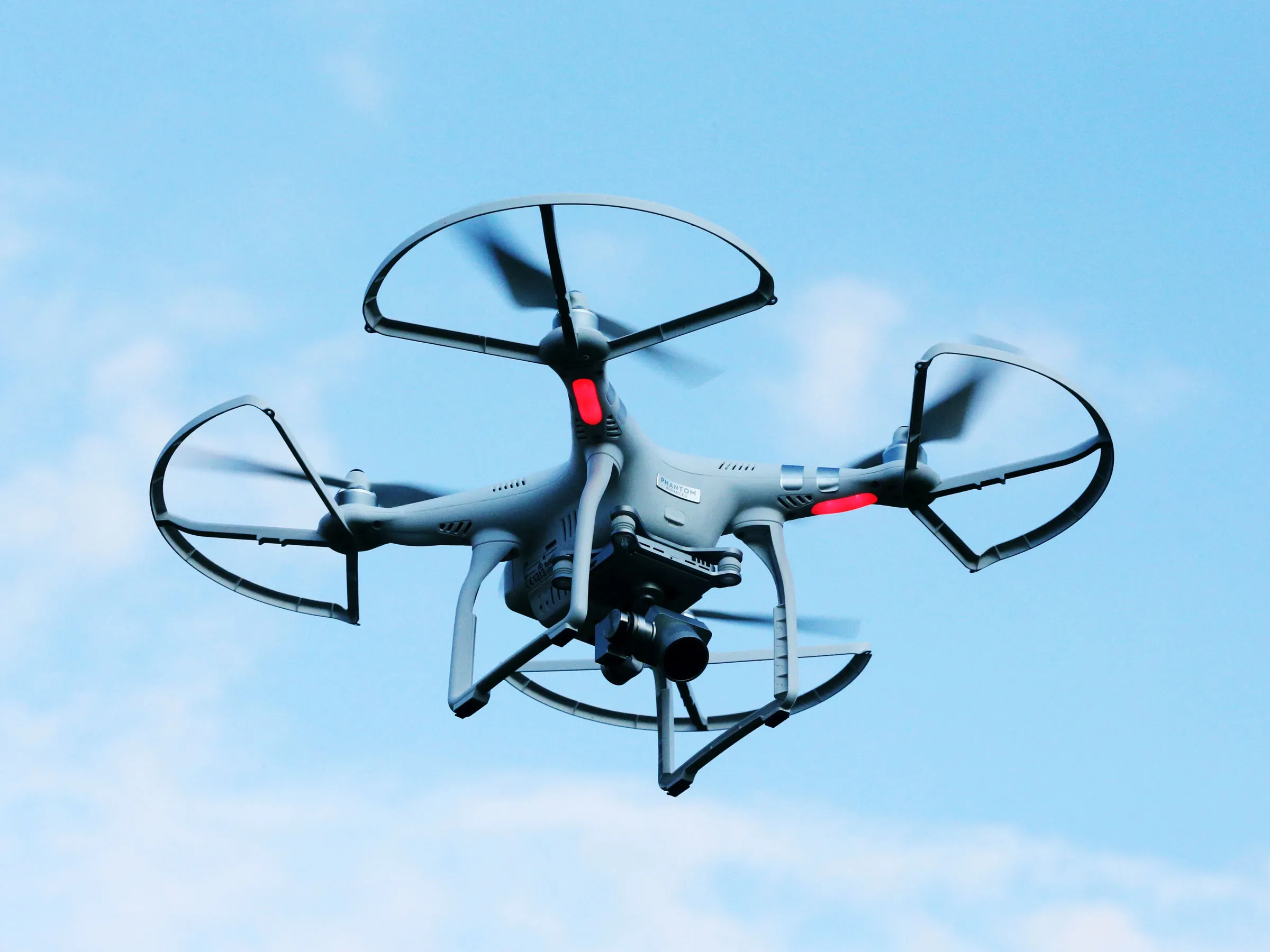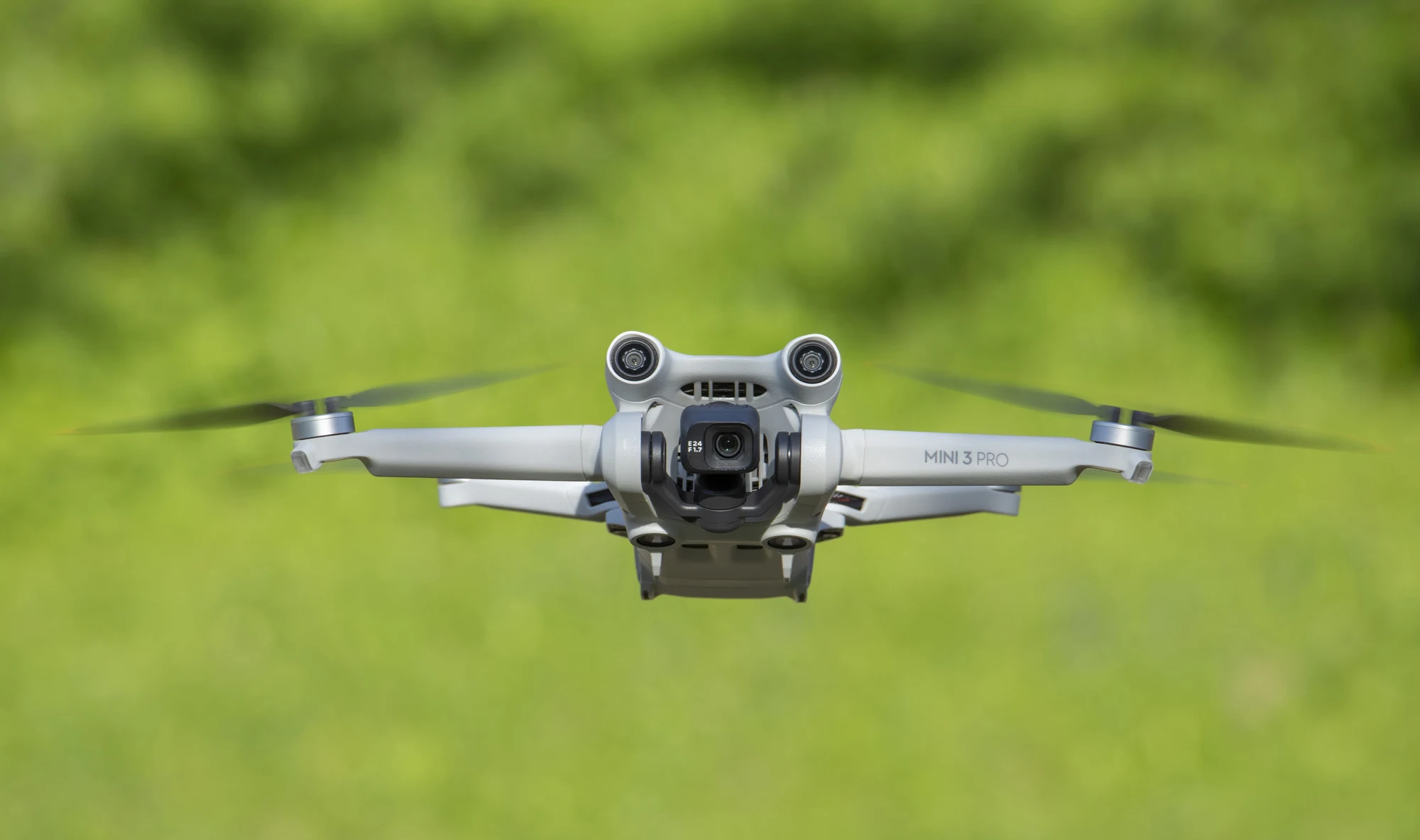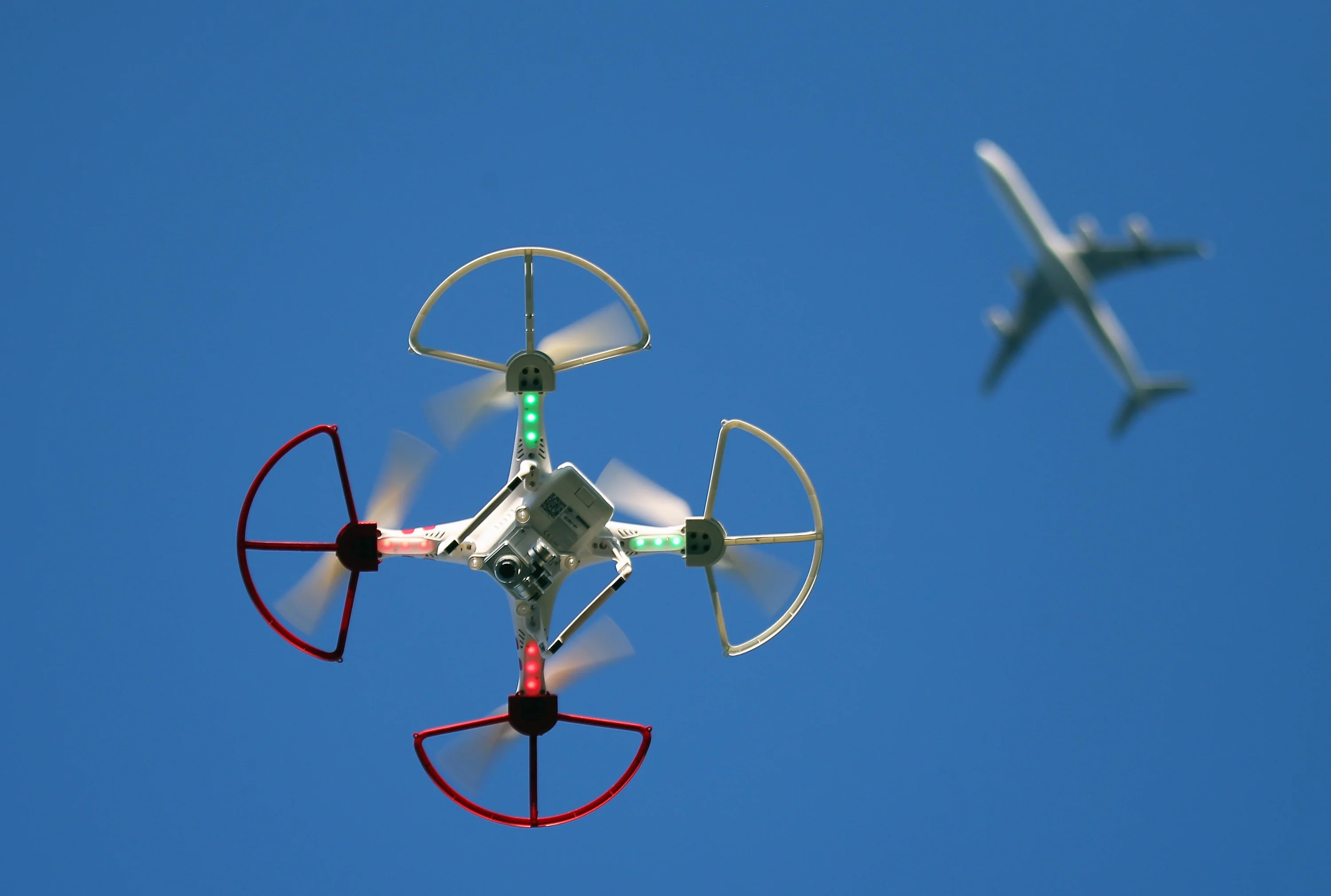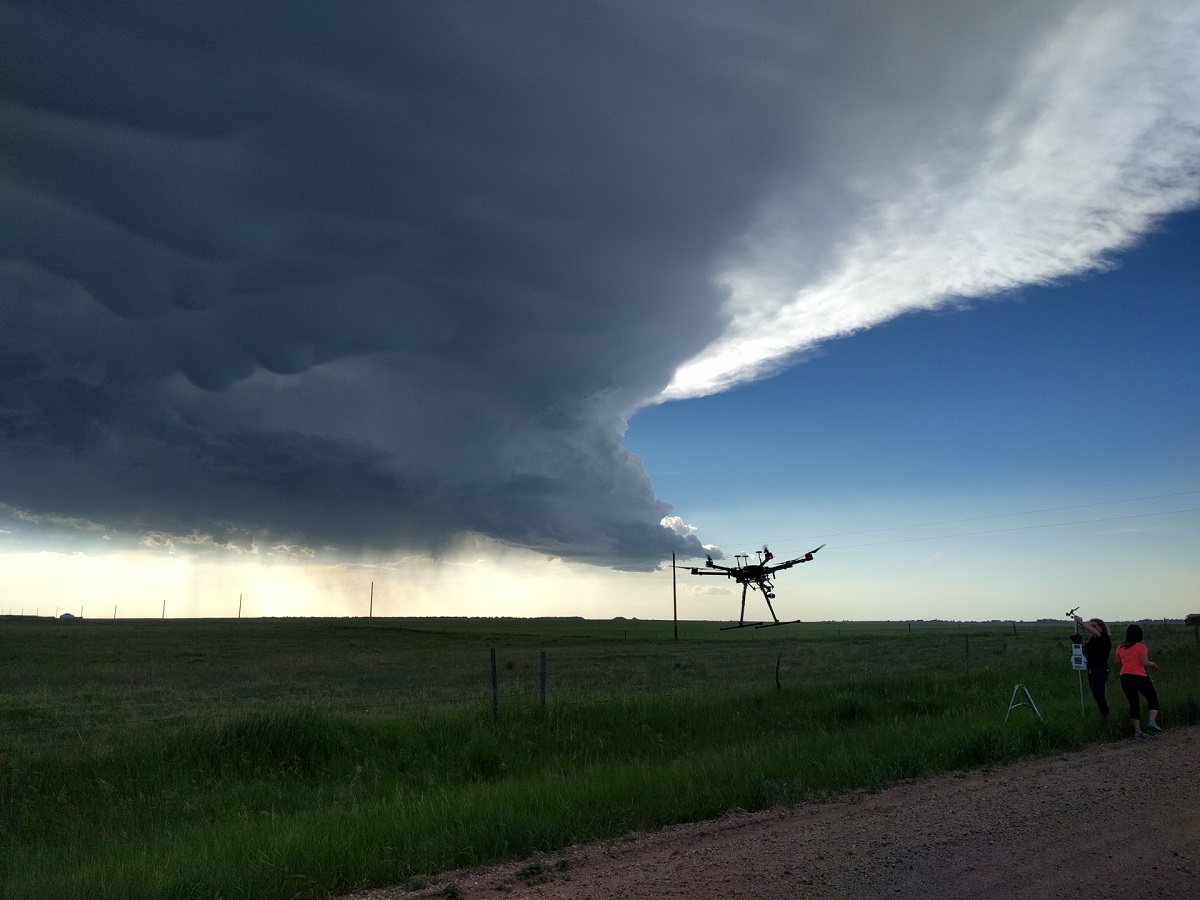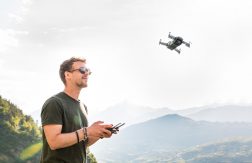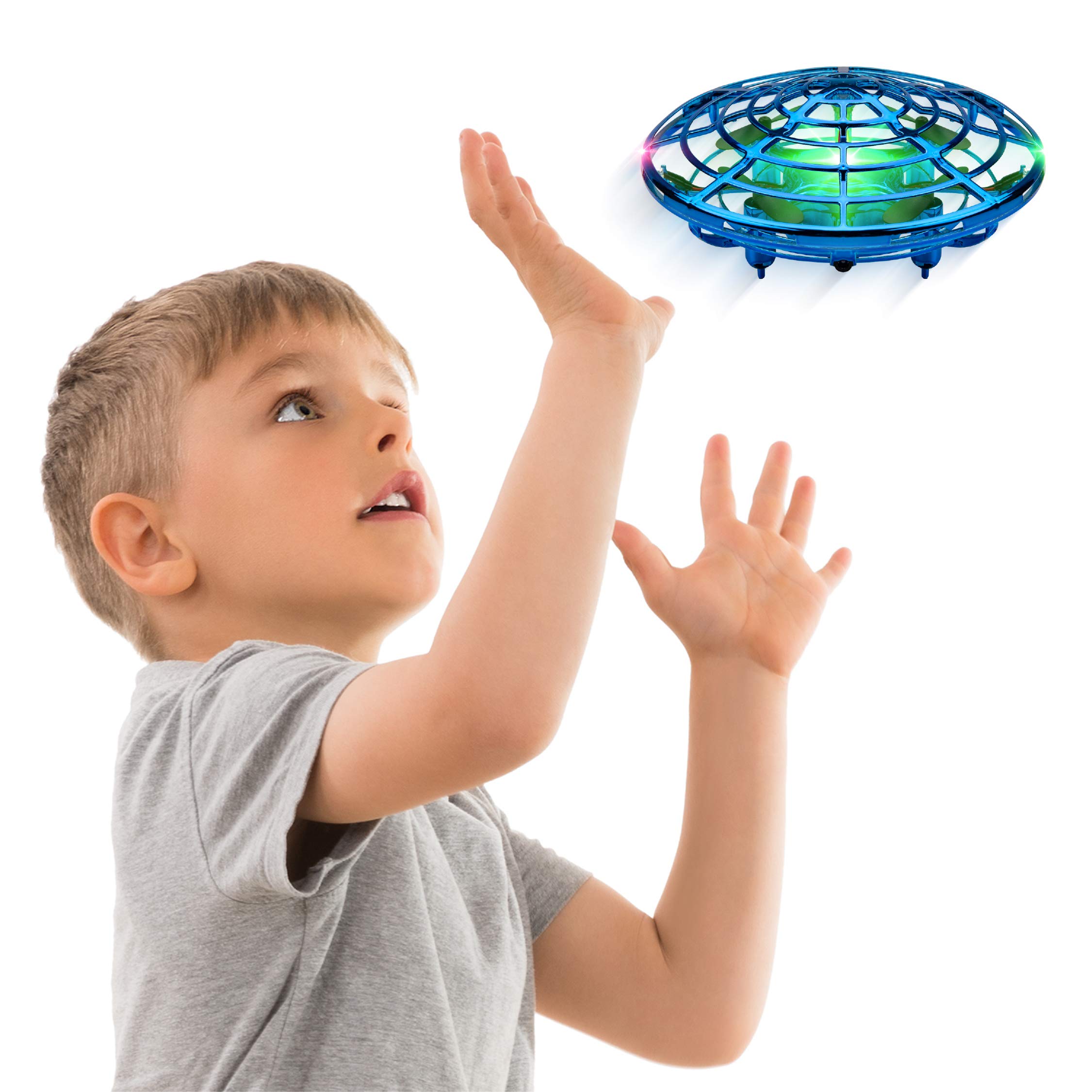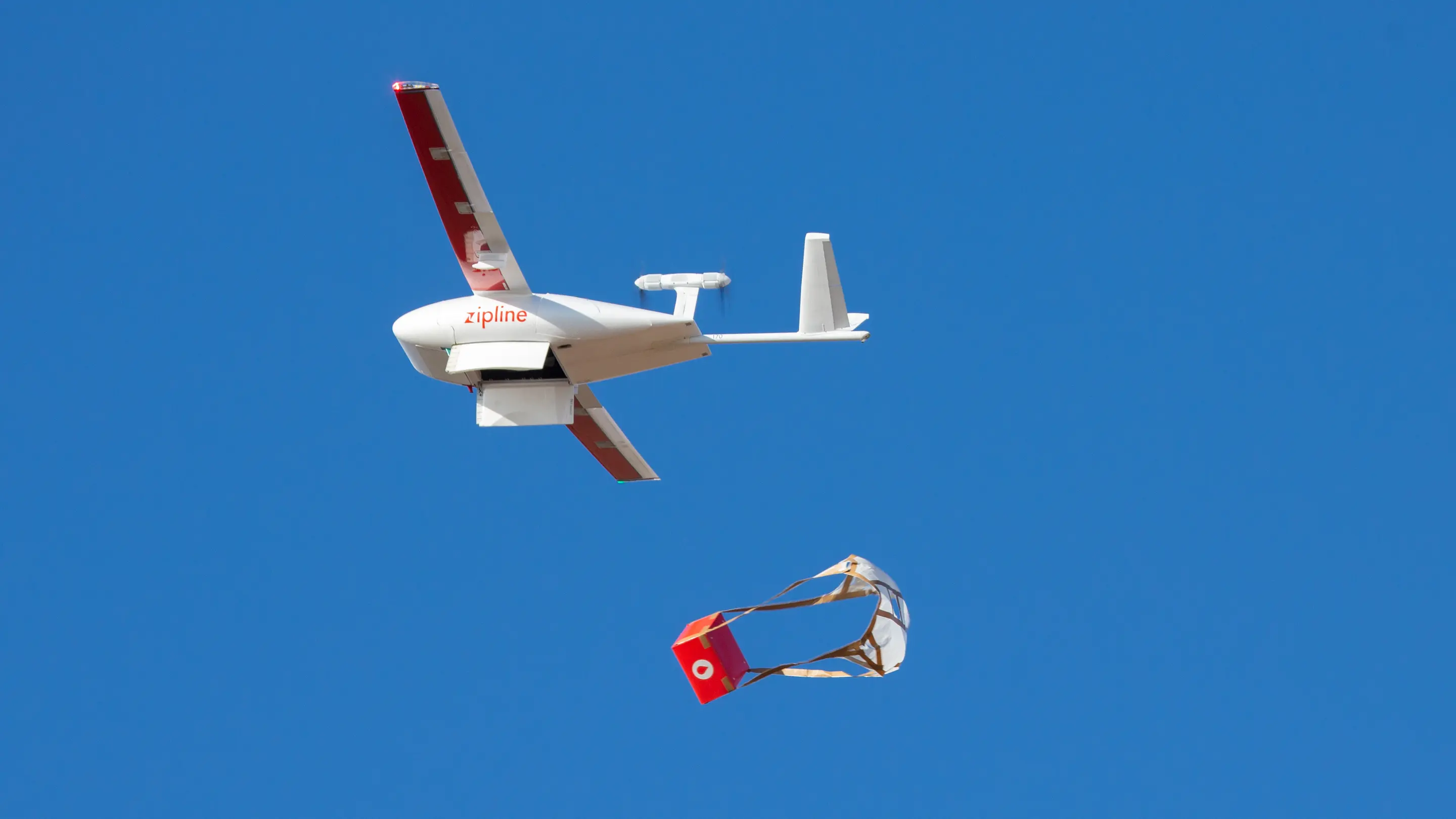Introduction
Welcome to the fascinating world of drones! In recent years, drone technology has rapidly gained popularity and become a game-changer in various industries. Whether you are a recreational enthusiast or a professional, understanding how drones work and how to operate them safely is essential.
Drones, also known as unmanned aerial vehicles (UAVs), are sophisticated aircraft that can be remotely controlled or operated autonomously. They have revolutionized photography, videography, delivery services, surveillance, and many other fields. The ability to capture breathtaking aerial shots, explore inaccessible areas, and perform tasks without human intervention has opened up a wide range of possibilities.
The history of drone technology dates back to the early 1900s when the first remote-controlled aircraft were developed. However, it was only in the past decade that drones became more accessible and affordable, thanks to advancements in technology and miniaturization.
Today, drones come in various shapes and sizes, ranging from small recreational quadcopters to larger multi-rotor and fixed-wing aircraft used for professional purposes. They are equipped with advanced features such as GPS navigation, obstacle avoidance systems, and high-resolution cameras.
Operating a drone requires knowledge of its components, flight controls, and the regulations that govern its use. Whether you fly a drone for recreational purposes or as part of your profession, it’s crucial to adhere to safety guidelines and stay up-to-date with the ever-evolving rules and regulations set by aviation authorities.
In this comprehensive guide, we will explore the fascinating world of drone technology, from how drones work and the different types available, to the controls, flight modes, cameras, and safety considerations. Whether you’re a beginner looking to grasp the basics or an experienced drone operator seeking advanced tips, this guide will provide you with valuable insights to help you become a proficient and responsible pilot.
History of Drone Technology
The history of drone technology can be traced back over a hundred years when the first remote-controlled aircraft was developed. In 1917, during World War I, the U.S. Army developed pilotless airplanes known as “aerial torpedoes” to serve as target practice for anti-aircraft gunners. These early drones were essentially modified bombers or planes that were flown remotely to test and refine anti-aircraft weapons.
In the following decades, drones progressed slowly as technology advanced. In the 1950s, the U.S. Air Force developed the “Radioplanes” series of drones. These were used primarily for reconnaissance missions during the Korean War, providing valuable intelligence without risking the lives of pilots. The Radioplane company, later acquired by Northrop Corporation, became one of the leading manufacturers of drones.
Throughout the 1960s and 1970s, drones continued to evolve, with advancements in electronics and miniaturization. Drones were used in various military operations, including the Vietnam War, where they were deployed for reconnaissance and surveillance purposes.
However, it wasn’t until the 21st century that drone technology took a significant leap forward. Rapid technological advancements in microprocessors, sensors, and battery life revolutionized the capabilities and accessibility of drones. This led to the rise of consumer drones, which became available to hobbyists and photographers.
Companies like Parrot, DJI, and Yuneec played a crucial role in popularizing consumer drones, introducing user-friendly models with advanced features like stable flight controls and high-resolution cameras. This opened up a whole new world of possibilities for aerial photography, videography, and recreational flying.
Alongside the consumer market, drones continued to be used extensively in the military and professional sectors. They were deployed for surveillance, search and rescue operations, monitoring infrastructure, and even delivery services. The versatility of drones, combined with their cost-effectiveness and efficiency, made them an indispensable tool in various industries.
As drone technology advanced, so did the regulations surrounding their use. Aviation authorities around the world established rules and guidelines to ensure the safe and responsible operation of drones. These regulations address areas such as drone registration, flight restrictions, and privacy concerns.
Looking to the future, the field of drone technology is set to continue its rapid expansion. Advancements in artificial intelligence, machine learning, and automation are paving the way for autonomous drones capable of performing complex tasks with minimal human intervention.
With the popularity of drones rising and their applications expanding, it’s an exciting time to be part of this technology-driven revolution. Whether you’re a hobbyist, a professional, or someone interested in the latest innovations, the future of drone technology promises even more incredible possibilities.
How a Drone Works
Understanding how a drone works is the foundation for becoming a skilled drone pilot. Drones rely on a combination of mechanical, electronic, and software components to achieve stable flight and perform various aerial tasks.
At the heart of a drone is the flight controller, which acts as the brain of the aircraft. It receives input from the pilot or automated system and processes data from the drone’s sensors, such as accelerometers and gyroscopes. The flight controller uses this information to adjust the speed of the motors and control the movement of the drone.
The drone’s motors, typically brushless electric motors, are responsible for generating the thrust and controlling the rotation of the propellers. By adjusting the speed of each motor, the flight controller can maneuver the drone forward, backward, sideways, or rotate it.
Stability during flight is crucial, and this is achieved through a combination of sensors and stabilization systems. Accelerometers measure the drone’s acceleration and tilt, while gyroscopes detect its orientation and rotation. Barometers provide altitude information, and GPS receivers enable precise positioning and navigation.
One of the most critical components on a drone is the battery. It provides power to the motors and the electronic systems onboard. Battery technology has seen significant advancements, allowing drones to fly for longer durations and perform more complex tasks. However, managing battery life and ensuring safe operation are essential considerations for drone pilots.
To control the drone’s movement, pilots use a remote controller or a mobile device with a dedicated app. The controller sends signals to the drone, indicating the desired direction, speed, and other flight parameters. In some cases, drones can be programmed to follow pre-defined flight paths or perform automated tasks using waypoint navigation systems.
Modern drones often come equipped with high-resolution cameras or gimbals to stabilize cameras for capturing smooth aerial footage or imagery. These cameras can be used for photography, videography, mapping, or other specialized applications. The visuals captured by the drone are either transmitted to a ground station in real-time or stored on an internal memory card.
Software and firmware play a crucial role in the operation of a drone, providing features like autonomous flight modes, advanced navigation systems, and intelligent flight controls. These software enhancements enable drones to perform tasks such as automated takeoff and landing, follow-me mode, waypoint navigation, and even object tracking.
Overall, a drone works by combining all these components into a sophisticated system. It’s the harmonious interplay between hardware, software, and the pilot’s skill that allows the drone to take flight, perform its tasks, and safely navigate the skies.
Parts of a Drone
A drone consists of several essential parts that work together to enable flight and perform various functions. Understanding these components is crucial for both drone operators and enthusiasts.
1. Frame: The frame serves as the structural backbone of the drone, holding all the components together. It is typically made of lightweight materials like carbon fiber or durable plastic to reduce weight without compromising strength.
2. Propellers: The propellers, also known as rotors or blades, generate the lifting force required for the drone to take off and stay airborne. They are usually made of reinforced plastic and spin at high speeds, creating thrust.
3. Motors: The motors are responsible for spinning the propellers and generating the necessary thrust. Most drones use brushless electric motors for their efficiency, reliability, and high performance.
4. Electronic Speed Controllers (ESCs): ESCs control the speed of the motors and ensure their synchronization. They receive signals from the flight controller and adjust the motor’s RPM (Revolutions Per Minute) accordingly.
5. Flight Controller: The flight controller is the “brain” of the drone, receiving inputs from the pilot or automated systems and sending commands to the motors. It uses information from built-in sensors to maintain stability and control the drone’s movement.
6. Battery: Drones are powered by rechargeable batteries, typically Lithium Polymer (LiPo) batteries. The battery provides the necessary electrical energy to run the motors and power other components onboard.
7. Sensors: Drones are equipped with various sensors to gather data about their surroundings and ensure stability. Accelerometers measure acceleration and tilt, gyroscopes detect orientation and rotation, barometers provide altitude information, and GPS receivers enable precise positioning and navigation.
8. Camera/Gimbal: Many drones come with integrated cameras or gimbals for aerial photography and videography. The camera captures high-quality images or video footage, while a gimbal stabilizes the camera, reducing vibrations and ensuring smooth shots.
9. Transmitter/Remote Controller: The transmitter, also known as a remote controller, is the handheld device used to control the drone. It sends commands and signals to the drone, allowing the pilot to control its movement, adjust settings, and activate various flight modes.
10. Receiver: The receiver is installed on the drone and receives the commands sent by the transmitter. It relays these commands to the flight controller, allowing the drone to respond to the pilot’s inputs.
11. Propeller Guards: Propeller guards are optional accessories that can be attached around the propellers for added safety. They help protect the propellers from damage and prevent injuries in case of accidental collisions.
These are just some of the key parts that make up a drone. Depending on the model and purpose, drones may have additional components such as obstacle avoidance sensors, LED lights for visibility, landing gear, payload release mechanisms, or specialized sensors for specific applications.
Understanding the different parts of a drone is essential for maintenance, troubleshooting, and customization. It allows drone enthusiasts and pilots to have a deeper appreciation for the technology and make informed decisions when choosing a drone or upgrading its components.
Types of Drones
Drones come in various types, each designed for specific purposes and applications. Understanding the different types of drones can help you determine which one best suits your needs or interests.
1. Quadcopter: The quadcopter is one of the most common drone types, characterized by its four propellers and X-shaped design. It offers stability, maneuverability, and ease of control, making it popular among beginners and recreational users.
2. Hexacopter and Octocopter: Hexacopters have six propellers, while octocopters have eight. These drones provide enhanced stability and lifting power, making them ideal for professional applications such as aerial photography, videography, and industrial inspections.
3. Fixed-Wing Drones: Unlike quadcopters, fixed-wing drones have a more traditional aircraft design with fixed wings and a fuselage. They are capable of sustained flight and are often used for long-range aerial mapping, surveillance, and agriculture applications.
4. First-Person View (FPV) Drones: FPV drones are equipped with a camera that provides a real-time video feed to the pilot, allowing for an immersive flying experience. These drones are popular among racing enthusiasts who use specialized goggles to view the flight from the drone’s perspective.
5. Nano/Micro Drones: Nano and micro drones are the smallest types, often palm-sized or smaller. They are lightweight, compact, and sometimes feature foldable designs, making them highly portable. These drones are great for indoor flying, learning the basics, or simply having fun.
6. Camera Drones: Camera drones are designed specifically for aerial photography and videography. They are equipped with high-resolution cameras, gimbals, and advanced stabilization systems to capture professional-grade imagery from the air.
7. Delivery Drones: Delivery drones are designed for transporting small packages over short distances. They are being developed by companies like Amazon and UPS for fast and efficient delivery of goods.
8. Autonomous Drones: Autonomous drones are equipped with advanced navigation systems and artificial intelligence capabilities, allowing them to operate without direct human control. They can perform tasks like mapping, surveying, and surveillance autonomously.
It’s important to note that these categories are not mutually exclusive, and many drones may fall into multiple types, depending on their features and capabilities. Additionally, there are specialized drones for specific industries, such as agricultural drones for crop monitoring or industrial inspection drones for infrastructure maintenance.
When choosing a drone, consider the intended use, your skill level, and any specific features or requirements you may have. Researching different models and understanding the capabilities of each type will help you make an informed decision and select the drone that best suits your needs.
Drone Controls
Mastering drone controls is essential for safe and effective flying. Understanding how to navigate and control a drone allows pilots to capture stunning aerial footage, perform precise maneuvers, and ensure a smooth flight experience. Let’s explore the key controls involved in operating a drone.
1. Throttle: The throttle control adjusts the drone’s altitude or vertical movement. It determines the motor’s speed, increasing or decreasing thrust to ascend or descend the drone.
2. Pitch and Roll: Pitch refers to the drone’s forward and backward movement, while roll controls its side-to-side motion. By adjusting these controls, pilots can fly the drone in various directions and angles.
3. Yaw: Yaw controls the drone’s rotation or turning movement. Adjusting the yaw control allows pilots to change the direction the drone is facing without altering its horizontal position.
4. Trim: Trim controls help fine-tune the drone’s stability and level flight. These adjustments compensate for any drift or imbalance, ensuring the drone hovers or flies straight without constantly adjusting the other controls.
5. Flight Modes: Many drones offer different flight modes, such as “Normal” or “Sport” mode. Normal mode provides stabilization assistance, making it ideal for beginners, while Sport mode disables certain flight assist features, allowing for faster and more agile flying.
6. Return-to-Home (RTH): Most drones have a dedicated RTH button or feature. When activated, the drone automatically returns to its takeoff location using GPS navigation. This feature is handy in case of signal loss or low battery situations.
7. Headless Mode: Headless mode allows the drone to be oriented relative to the pilot’s position, rather than the drone’s actual direction. This simplifies controls, especially for beginners, by eliminating the need to adjust controls based on the drone’s orientation.
8. Flight Speed: Drones often have adjustable flight speed settings to accommodate different skill levels and tasks. Beginners may start with slower speeds to get comfortable with the controls, while experienced pilots can increase the speed for more dynamic maneuvers.
9. Gimbal Control: For drones equipped with gimbals, pilots can control the camera stabilization and tilt angles using dedicated controls on the remote controller. This allows for smooth camera movements and capturing the desired shots.
Understanding and practicing these controls are essential for safe and precise flying. Beginners should start by mastering the basic controls in a controlled environment before attempting more complex maneuvers. Regular practice and familiarity with the controls will enhance your piloting skills and enable you to make the most of your drone’s capabilities.
Drone Flight Modes
Drone flight modes offer pilots a range of capabilities and features that enhance their flying experience and allow for more creative and efficient operation. Let’s explore some common flight modes found in many drones.
1. Normal/Manual Mode: In normal or manual mode, the drone operates with standard flight settings and controls. This mode requires the pilot to have full control over the throttle, pitch, roll, and yaw to maneuver the drone.
2. Hover/Stabilization Mode: Hover mode, also known as stabilization mode, automatically maintains a stable hover when the pilot releases the controls. It helps beginners gain confidence and stability when flying, ensuring the drone remains at a fixed position.
3. Follow-Me Mode: Follow-me mode enables the drone to track and follow a designated target, typically the pilot or a mobile device. The drone utilizes GPS or visual tracking to maintain a fixed distance and altitude from the target, capturing dynamic footage while the pilot is on the move.
4. Waypoint Navigation: Waypoint navigation allows pilots to predefine a flight path for the drone. Using GPS coordinates or mapping software, the drone autonomously follows the designated waypoints, performing automated actions at each point, such as capturing photos or videos.
5. Orbit Mode: Orbit mode enables the drone to circle around a specific subject or point of interest. The drone flies in a circular path around the target, capturing consistent footage from different angles. This mode is popular for creating cinematic shots and detailed aerial visuals.
6. Sport Mode: Sport mode unleashes the drone’s full potential, maximizing its speed and agility. The drone’s response becomes more responsive, allowing for faster and more dynamic flight. This mode is ideal for experienced pilots and action-packed aerial photography or racing.
7. Return-to-Home (RTH) Mode: Return-to-Home mode is a valuable safety feature that automatically guides the drone back to its takeoff location. Using GPS navigation, the drone retraces its flight path or follows a direct route to return home. RTH mode is handy in low battery situations or when the pilot loses sight of the drone.
8. Gesture Mode: Some drones offer gesture mode, allowing pilots to control the drone using hand gestures. This hands-free control feature enables pilots to take aerial selfies or command the drone to follow specific gestures for predefined actions.
It’s important to familiarize yourself with the flight modes specific to your drone model. Understanding how to activate and utilize these modes will enhance your drone flying experience and enable you to capture stunning and unique footage.
Takeoff and Landing
Mastering the takeoff and landing procedures is essential for safe and controlled drone operations. Proper execution of these maneuvers ensures a smooth start and end to every flight. Let’s delve into the steps involved in takeoff and landing.
Takeoff:
1. Choose an appropriate location: Select a suitable takeoff area that provides ample space, clear of obstacles, and allows for a clear line of sight.
2. Check pre-flight conditions: Before taking off, ensure that the drone’s batteries are fully charged, the propellers are securely mounted, and all connections are secure.
3. Power on the drone: Turn on the drone by pressing the power button, usually located on the drone body or its battery.
4. Calibrate the compass: If required by your drone model, follow the calibration procedure to ensure accurate heading information.
5. Begin the takeoff procedure: Place the drone on a flat surface and activate the takeoff sequence using the designated control on your remote controller or drone app.
6. Gradually increase throttle: Slowly increase the throttle to lift the drone off the ground. Be gentle with the controls to ensure a smooth ascent.
7. Maintain control and altitude: Once the drone is airborne, maintain control using the pitch, roll, and yaw controls. Stabilize the drone at a comfortable altitude, ensuring proper clearance from the ground and any nearby obstacles.
Landing:
1. Choose a suitable landing zone: Identify a safe landing spot that is clear of obstacles and provides enough space for a controlled landing.
2. Plan the approach: Assess the wind conditions and plan a suitable approach path to land the drone safely.
3. Start the descent: Gradually decrease the throttle to initiate the descent and reduce the drone’s altitude.
4. Monitor the descent: Continuously monitor the drone’s position, altitude, and surroundings during the descent. Adjust throttle and control inputs as necessary to maintain a controlled descent.
5. Prepare for landing: When the drone is close to the ground, reduce throttle further to slow down the descent rate.
6. Land smoothly: Aim to land the drone gently and smoothly onto the designated landing spot. Apply slight backward pitch to slow down the drone’s forward momentum if needed.
7. Power off the drone: Once the drone has landed safely, power off the motors by switching it off using the designated control or remote controller button.
Takeoff and landing are critical phases of a drone flight. Practice these maneuvers in open areas, away from obstacles or crowds, until you become comfortable and confident in executing them. Following the proper procedures and maintaining a cautious approach will contribute to a safe and successful flight experience.
Maneuvering a Drone
Mastering the art of maneuvering a drone is key to capturing dynamic shots, navigating through obstacles, and executing precise flight movements. By understanding the various flight controls and practicing different maneuvers, you can enhance your piloting skills and unlock the full potential of drone flying.
1. Basic Controls: Familiarize yourself with the basic flight controls, including throttle, pitch, roll, and yaw. Throttle controls the altitude, pitch and roll adjust the drone’s forward/backward and side-to-side movement, and yaw controls the rotation.
2. Hovering: Achieving a stable hover is essential for capturing steady footage or maintaining a fixed position. Practice balancing the throttle and making fine adjustments to maintain a steady hover.
3. Forward and Backward Movement: To execute forward flight, gradually increase the throttle and push the pitch control forward. For backward movement, decrease the throttle and pull the pitch control backward.
4. Sideways Movement: Use the roll control to move the drone left or right. Push the roll control to the right for rightward movement and to the left for leftward movement.
5. Turning: The yaw control allows the drone to rotate horizontally. To turn the drone clockwise, push the yaw control to the right. To turn counterclockwise, push the yaw control to the left.
6. Banked Turns: Banked turns involve coordinated movements of roll and yaw controls to execute smooth and dynamic turns. Combine the roll and yaw controls to initiate the turn and maintain a balanced bank angle.
7. Figure 8 Flight: Mastering figure 8 flight patterns adds a creative element to your drone piloting. Execute smooth turns while maintaining consistent altitude and speed to achieve seamless figure 8 patterns in the air.
8. Avoiding Obstacles: Practice flying around and maneuvering through obstacles, such as trees or structures, to develop spatial awareness and improve your obstacle avoidance skills. Use slow and precise movements in confined spaces.
9. Flight Patterns: Explore different flight patterns to add variety and creativity to your aerial footage. Experiment with flyovers, orbits, spirals, and aerial tracking shots to capture stunning visuals.
10. Advanced Flying Techniques: Once you have mastered the basic maneuvers, you can explore more advanced flying techniques, such as flips, rolls, and dives. However, these maneuvers should only be attempted by experienced pilots in appropriate flying conditions.
Remember to always fly within your skill level and exercise caution when attempting new maneuvers. Practice in open areas away from crowds and follow all local regulations and guidelines. Regular practice and experimentations will enhance your drone piloting skills, enabling you to achieve captivating shots and navigate with confidence.
Drone Cameras and Imaging
Drone cameras have revolutionized the fields of photography and videography, providing a whole new perspective by capturing stunning aerial imagery. With advancements in technology, drone cameras have become increasingly sophisticated, offering high-resolution imaging and innovative features for professional and recreational use.
1. Camera Quality: Drone cameras vary in resolution, from basic models capturing 1080p HD video to professional-grade cameras capable of shooting 4K or even higher-resolution footage. Higher-resolution cameras offer greater detail and clarity in images and videos.
2. Gimbal Stabilization: Many drones are equipped with gimbals, which are mechanical stabilizers that keep the camera steady during flight. This helps eliminate vibrations and unwanted movements, ensuring smooth and stable footage even in turbulent conditions.
3. Field of View (FOV): The field of view refers to the extent of the scene that the camera can capture. Drones offer various FOV options, from narrow to wide angles. Wide-angle lenses capture a broader view, allowing for expansive landscape shots.
4. Photo and Video Modes: Drone cameras provide a range of shooting modes, including single-shot photos, burst mode for capturing multiple photos in quick succession, and time-lapse mode to create stunning time-lapse videos. Some models also offer HDR (High Dynamic Range) and RAW capabilities for enhanced photo editing options.
5. Live Video Streaming: Many drones allow for live video streaming, enabling real-time monitoring and live broadcasts of the drone’s camera feed. This feature is particularly useful for remote inspections, live events coverage, and sharing the flight experience with others.
6. Subject Tracking: Advanced drone cameras can lock onto and track a specific subject, keeping it in frame even as the drone moves. This feature is invaluable for capturing action sequences or following moving targets.
7. Obstacle Avoidance: Some drone cameras are equipped with obstacle avoidance sensors, enabling the drone to detect and safely navigate around obstacles in its flight path. This feature enhances safety and protects the camera and drone from potential collisions.
8. Additional Features: Other camera features can include zoom capabilities, advanced image stabilization, panoramic modes for capturing wide-angle panoramic photos, and even thermal imaging or multispectral imaging for specialized applications in agriculture or environmental monitoring.
When choosing a drone camera, consider your specific imaging requirements and the type of footage you aim to capture. Understand the camera’s specifications, capabilities, and modes to make an informed decision. Regularly practice and experiment with different camera settings to unlock the full potential of your drone’s imaging capabilities and capture breathtaking aerial imagery.
Safety Considerations for Drone Flying
Flying a drone can be an exciting and rewarding experience, but it’s essential to prioritize safety to prevent accidents and ensure responsible operation. Here are some crucial safety considerations every drone pilot should keep in mind:
1. Know and follow the regulations: Familiarize yourself with the local regulations and guidelines for drone flying in your area. This includes understanding airspace restrictions, flight altitude limits, and any required permits or licenses.
2. Perform pre-flight checks: Before each flight, conduct a pre-flight checklist to ensure that your drone and its components are in good working condition. Check the battery level, propellers, and drone body for any damage or loose connections.
3. Fly in appropriate weather conditions: Be mindful of weather conditions before flying. Avoid flying in strong winds, rain, or fog, as these conditions can affect the stability and control of the drone.
4. Maintain line of sight: Keep the drone within your line of sight at all times during the flight. This ensures that you have full control over the drone and can respond quickly to any potential hazards or obstacles.
5. Respect privacy: Be respectful of people’s privacy and avoid capturing images or videos in areas where individuals have a reasonable expectation of privacy. Exercise caution when flying near private properties, schools, or other sensitive locations.
6. Stay away from airports and other restricted areas: Drones should never be flown near airports or other restricted areas where manned aircraft operate. Respect no-fly zones and designated restricted areas to avoid potential collisions or interference with air traffic.
7. Avoid flying over crowds or congested areas: To minimize the risk of accidents or injuries, avoid flying your drone over crowded areas or near major roadways. Maintain a safe distance from people, buildings, and vehicles.
8. Be aware of battery limitations: Understand the limits of your drone’s battery life and plan your flights accordingly. Avoid pushing the battery to its limits as it may result in a sudden loss of power during flight.
9. Take precautions with wildlife: Be considerate of wildlife when flying in natural areas. Avoid disturbing or unnecessarily approaching animals, as drones can cause stress or harm to them.
10. Continuously update your skills and knowledge: Stay up-to-date with the latest drone regulations, safety practices, and flight techniques. Participate in training programs, workshops, or online communities to enhance your knowledge and skills as a responsible drone pilot.
By following these safety considerations, drone pilots can enjoy the thrill of flying while ensuring the safety of themselves, others, and the aircraft. Prioritizing safety not only protects people and property but also helps maintain a positive reputation for the drone community as a whole.
Regulations and Legal Requirements for Drone Flying
Drone flying is subject to various regulations and legal requirements imposed by aviation authorities worldwide. Understanding and adhering to these rules is crucial to ensure safe and responsible operation. Here are some key regulations and legal requirements commonly applied to drone flying:
1. Registration: In many countries, drones above a certain weight threshold must be registered with the aviation authority or regulatory body. This helps ensure accountability and traceability of drone operators.
2. Flight Restrictions: Aviation authorities establish flight restrictions and no-fly zones to protect the safety and security of airspace. These zones include airports, military installations, government buildings, and other sensitive areas. Pilots must familiarize themselves with these restrictions and plan their flights accordingly.
3. Altitude and Distance Limits: Many regulations impose altitude and distance limits for drone flights. These limits vary from country to country but are typically set to ensure the drone remains within line of sight and does not interfere with manned aircraft.
4. Visual Line of Sight (VLOS): Most regulatory bodies require drone pilots to maintain a clear and unobstructed visual line of sight with their aircraft during flight. Flying beyond visual range or using first-person view (FPV) goggles without a visual observer is often prohibited.
5. Time of Day Restrictions: Some countries restrict flying drones during certain times of the day or specify illumination requirements for night flights. These restrictions aim to enhance safety and avoid potential hazards associated with low visibility conditions.
6. Privacy and Data Protection: Drone pilots must be mindful of privacy laws and regulations. Capturing images or videos of individuals without consent in areas with a reasonable expectation of privacy is typically prohibited. Ensuring the protection of personal data collected by drones is also essential.
7. Commercial Operations: If drones are operated for commercial purposes, additional regulations often apply. This may include obtaining special licenses or certifications, complying with specific operating conditions, and maintaining liability insurance.
8. Risks and Liability: Drone pilots are responsible for ensuring that their flights do not pose risks to people, property, or other aircraft. They may be held liable for any damages or injuries caused by their drone operations.
It’s essential for drone pilots to research and understand the regulations specific to their country or region. Keeping abreast of any updates or changes to regulations is also crucial to ensure compliance. Violating these regulations not only risks penalties and fines but also undermines the safety and reputation of the drone community as a whole.
By respecting and adhering to regulations, drone pilots contribute to the responsible and sustainable development of the drone industry while fostering a safe and inclusive environment for all airspace users.
Flying a Drone for Recreation or Profession
Whether for recreation or profession, flying a drone opens up a world of exciting possibilities for enthusiasts and professionals alike. Here, we’ll explore the key considerations and benefits for both recreational and professional drone pilots.
Recreational Flying:
Recreational drone flying offers enthusiasts a thrilling and creative outlet for capturing aerial photos and videos, exploring new perspectives, and enjoying the sheer joy of flight. Here are some key considerations for recreational drone pilots:
1. Learning the Basics: Beginners should start by familiarizing themselves with their drone’s controls, understanding flight principles, and practicing in open areas to build their piloting skills.
2. Creative Expression: Recreational pilots have the freedom to experiment with different flight maneuvers, explore aerial photography and videography techniques, and unlock their creativity by capturing stunning imagery from unique perspectives.
3. Finding Suitable Locations: Recreational pilots can explore various landscapes, such as mountain ranges, beaches, or urban environments, to find picturesque and captivating locations for their flights.
4. Participating in Community: Joining drone communities or clubs allows recreational pilots to connect with like-minded individuals, share experiences, and learn from others. This fosters a sense of camaraderie and provides opportunities for collaborative learning.
Professional Flying:
For those flying drones professionally, whether as photographers, videographers, surveyors, or inspectors, drones offer valuable tools to enhance their work. Here are some key considerations for professional drone pilots:
1. Specialized Training: Professional pilots often undergo specialized training and obtain necessary certifications to ensure competence in flight operations, safety procedures, and understanding relevant regulations specific to their industry.
2. Aerial Photography and Videography: Drones provide professionals with the ability to capture stunning visuals for commercial purposes. They can capture aerial shots for films, documentaries, promotional videos, real estate listings, and more.
3. Industrial Applications: Professionals can utilize drones for industrial applications such as infrastructure inspections, construction site monitoring, agricultural surveys, environmental monitoring, and search and rescue operations. Drones enable efficient data collection and reduce risks associated with manual inspections.
4. Legal and Business Considerations: Professional pilots must comply with relevant regulations and licensing requirements specific to their industry or country. They should also consider liability insurance coverage and operate with the necessary business licenses and permits.
Both recreational and professional drone flying offer unique experiences and opportunities. Whether for personal enjoyment or as part of a profession, responsible drone flying contributes to the growth and positive reputation of the drone community.
Conclusion
As we conclude this guide, it’s evident that drones have transformed the way we capture images, explore our surroundings, and carry out various tasks. Whether you’re a recreational enthusiast or a professional pilot, understanding the intricacies of drone technology, flight controls, and safety considerations is essential for a rewarding and responsible flying experience.
From the early days of remote-controlled aircraft to the versatile and advanced drones of today, technology has propelled us to new heights. Drones offer us the ability to capture breathtaking aerial footage, explore inaccessible locations, and perform tasks efficiently and effectively.
However, with the joys of drone flying come responsibilities. Adhering to regulations, practicing safety measures, and respecting privacy considerations are imperative for both recreational and professional drone pilots. By doing so, we ensure the continued growth and positive impact of the drone industry.
Recreational pilots can unleash their creativity, capture stunning footage, and connect with others in the drone community. Professionals can leverage drones to enhance their work in photography, videography, inspection, and more, opening up new opportunities and expanding their capabilities.
As technology continues to advance, we can look forward to even more exciting developments in the world of drones. From autonomous drones to innovations in imaging and flight controls, the possibilities are boundless. It’s an exciting time to be part of this ever-evolving field.
Remember, flying a drone comes with responsibilities. Stay informed, practice safe piloting procedures, and never lose sight of the importance of respecting privacy and adhering to regulations. By doing so, we can all enjoy the remarkable benefits of drones while ensuring a harmonious coexistence with other airspace users and the communities in which we fly.







